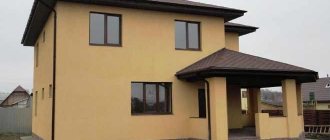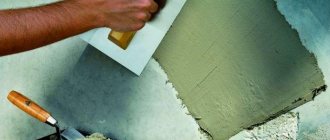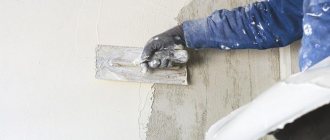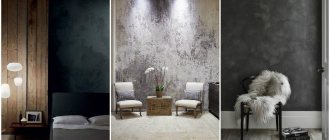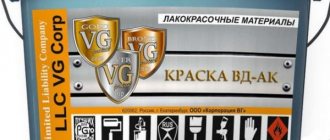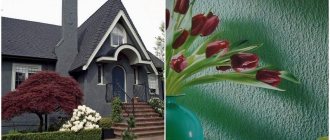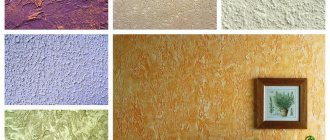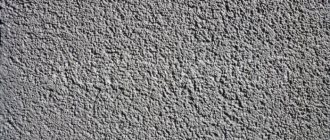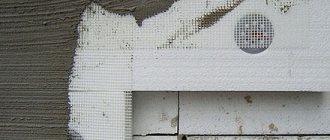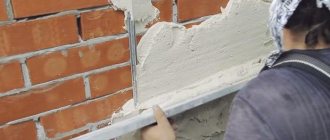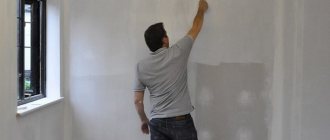To decorate the surfaces of rooms, people have come up with a wide variety of finishing materials. Plaster mixtures are classified as a separate category. The most popular is acrylic plaster for walls.
In comparison with its counterparts, the material is distinguished by its universal qualities, because it is widely used for indoor and outdoor work. Today I propose to understand what types of acrylic plaster there are, its features, the pros and cons of the material and the technology for its application. We’ll also see what kind of reviews acrylic plaster mixtures receive.
What is acrylic plaster made of?
Plaster mortar, the main component of which is acrylic resin, is an artificial synthetic composition. However, it is considered an environmentally friendly finishing material. Thanks to acrylic, the finished coating is strong, durable and durable. But in addition to resin, the composition of a decorative acrylic plaster solution is not complete without the presence of other ingredients:
| Ingredient: | Description: |
| Modifiers | The addition of these elements gives the mixture different properties. That is, the presence of a modifier improves the desired technical qualities of the material. |
| Dyes | Basically, acrylic plaster solutions are already produced in color (the coloring pigment is introduced during the preparation of the mixture). Thanks to the correct proportion of dyes, the finished surface will retain its original color for a long time, and the building material will remain of high quality and will not change its properties. |
| Interspersed | They are responsible for what the structure of the covered plane will be. Acrylic paste can contain a variety of structuring substances - crushed quartz and other small inclusions. |
Advantages and disadvantages of acrylic facade plaster mortar
The acrylic composition has many more advantages than disadvantages. Speaking about the shortcomings, we can highlight just a few points:
- high price. The material is environmentally friendly. The composition includes expensive components, due to which the durability and strength of the coating is achieved;
- poor ability to pass steam. The film that forms on the plane after hardening of the composition has poor vapor permeability. As a result, the walls are practically unable to “breathe”. Therefore, I do not recommend finishing the facade with acrylic plaster if you have insulated the walls using fibrous material (dense stone mineral wool);
- low resistance to UV rays. Bright sun has an adverse effect on the color saturation of the coating (paints become faded relatively quickly). Therefore, acrylic plaster is best suited for interior work if you want to give the surface of the room a rich color shade. And also to extend the service life of the coating, it is recommended to apply the finishing layer of acrylic paints for interior plastering work.
- high ability to accumulate static voltage. Dust and debris are attracted to the surface faster, so you need to monitor the cleanliness of the coating more often.
What is acrylic plaster?
This concludes the disadvantages of acrylic plaster paste. Now let’s look at a number of undeniable advantages of the material, thanks to which acrylic plaster mixture is the most popular among others:
- Durable. The coating can withstand significant mechanical damage that other types of plasters cannot cope with.
- Resistant to wear. It will not crumble or peel off. When rubbed, no stains will appear on it. If the coating was applied correctly, the finished surface is guaranteed to last for several decades. At the same time, it will not lose its attractive appearance.
- Resistant to temperature changes and moisture. She is not afraid of frost, rain and snow.
- Contains non-flammable components. This plaster is recommended for use when finishing facades that are insulated with flammable foam material (foamed polystyrene).
- The building material is produced as a ready-to-use solution. There is no need to calculate proportions to prepare the required amount of mixture.
- The paste is easy to apply on a plane. It is plastic, does not spread, does not form a lump. Even a non-professional can handle the job of decorating the surface with such plaster.
Advice from the experts
Experienced builders know how to avoid mistakes when working with acrylic elastic plaster. They advise:
- Do not start work when tired. It is better to wait until the person is healthy and well rested.
- It is better to start the process in the morning to do everything at once. This way you can avoid differences between the walls and achieve a uniform decorative layer.
- Do not forget about personal protective equipment to prevent the solution from getting into your eyes.
- It is better to apply it from a corner, distributing the acrylic composition over the wall.
- Drying should occur under natural conditions. There is no need to speed it up by using hair dryers, heaters or similar devices. This is fraught with the formation of cracks and destruction of the created layer.
- The optimal thickness of the acrylic layer is 2-3 mm. There is no need to make it thicker.
- The process is performed at temperatures from +5 to +25 degrees, wind and draft are not allowed. Humidity no more than 60%.
Acrylic plaster is a universal option that can be used to decorate a room inside and outside. Thanks to it, a unique appearance, Venetian gloss and modern design are created. And thanks to its characteristics, it will last for decades.
What is the difference between acrylic plaster and other varieties
- Acrylic plasters are produced with a ready-to-use solution. Unlike its counterparts, this building material is not produced in dry mixtures.
- The main component is acrylic resin. This ingredient in the composition, after hardening, makes the coating durable and strong.
- The price of acrylic plaster paste is higher than that of a mineral mixture, but significantly lower than silicone or silicate.
- Resistant to prolonged exposure to moisture and frost.
- Elastic. It is easy to apply and spread over a plane. It adheres firmly to various surface bases, be it wood, brick or stone, polystyrene foam, gas block or foam block, fibrous material, OSB sheet.
- Good for indoor and outdoor use.
- It is used as decorative (for decorating surfaces) and repair (for sealing gaps or cracks on a plane).
Surface preparation
To ensure that the plaster coating is durable, does not peel off, sticks to the wall, does not bulge, does not fall through, does not turn red, and does not become covered with stains of leaked salts, the base is prepared before applying it:
- Oil stains and efflorescence are removed, fungal and mold areas are cleaned and disinfected;
- remove old paint and wallpaper;
- remove excess metal objects (nails, screws), insulate the remaining ones;
- tap the old plaster finish, remove peeling areas, knock down protrusions, repair cracks and potholes;
- uneven walls are leveled with putty or cement plaster;
- in brick walls, use a chisel to deepen the seams a centimeter;
- remove dust;
- wooden coverings are covered with fiberglass mesh;
- apply a primer to the base, then leveling putty;
- dried.
As a result, the wall should be clean, smooth, slightly rough, and dry.
wall preparation
Under acrylic plaster, applying a primer is a necessity, since when water is drawn out of the solution by the base material, the ability of the plaster composition to properly harden is lost. The coating will be defective. To prevent this from happening, the pores of the walls must be reliably plugged with a primer.
Features of facade plaster mixture
Varieties of acrylic plaster
When choosing a composition for decorating the facade plane, do not forget that a universal option cannot be found. Today, the market offers a wide variety of acrylic plaster for exterior use, the price of which depends on the type of composition and its brand. The brand and manufacturer of the paste are selected according to the operating conditions and goals set for the finishing material:
- high humidity;
- significant amplitude of air temperature fluctuations;
- high level of dust formation;
- plenty of hot sunny days.
The surface of the room, finished with acrylic plaster, has a high degree of impact resistance. This coating is not afraid of mechanical influences (unless, of course, it is hit with a hammer). Easy to care for. It is enough to direct a water jet and all the dirt will be easily washed away from the surface. The main difference between each type of facade acrylic plaster mortar is the texture of the resulting coating.
Acrylic plaster in the interior
There are three main types:
- Acrylic bark beetle plaster. The subspecies got its name due to the similarity of the finished coating to the surface of wood eaten away by insects. Decorating a plane is easy and there is no need to use specialized tools to create a pattern. According to consumer reviews, the finished coating has high hardness and good water-repellent properties.
- Fur coat. It is also called “pebble plaster”. It is less susceptible to contamination than the “bark beetle” coating due to the absence of deep cavities.
- Mosaic plaster. The filler is multi-colored crushed stones or granules. No dyes are added to the composition.
The same plaster composition can be presented under different names. Often, a manufacturer names a product after its company. This name further serves as a distinctive sign of the building material. For example, Ceresit produces a huge variety of finishing materials. Among them is the so-called acrylic plaster Ceresit.
Finishing process
Speaking about how to apply decorative plaster, it is worth emphasizing that the work is done quite simply and sometimes you may not even need the help of specialists. In order to apply plaster there is no need to level the walls and this is its advantage.
The design of this coating can be complex, for example, made in the Venetian style, or romantic and simpler. Only your capabilities and taste preferences are taken into account.
Acrylic plaster application technology
Each type of plaster mixture has some specific differences when applied to the surface. But still, the surface should be covered with acrylic plaster, taking into account the following stages of the work process:
- We prepare the surface. The walls should be leveled as much as possible, since the acrylic composition is applied in a thin layer and the coating will not hide strong unevenness.
- We prime the plane. When applying the primer layer, dust and dirt are removed, micropores and cracks are sealed. Therefore, the putty composition will adhere tightly to the wall surface.
- We apply plaster. Depending on the type of mixture (it can be thin- or thick-layer), we use the necessary tools.
Acrylic plaster in the living room
We lay thin layers by hand. Here you may need a trowel, spatula, sprayer or roller. This decorative plaster composition has unsurpassed plasticity and can be easily applied even by a beginner. It is more convenient to apply thick layers of solution using a special machine. Here it is best to use dry mixtures, which are diluted with water to the required consistency. In any case, before starting work, carefully read the instructions on the packaging for applying the type of plaster you are using.
It is recommended that the surface finished externally with plaster mortar be additionally coated with a special acrylic facade plaster paint for exterior use. This will extend the life of the decorative coating. For clarity, I advise you to watch a video in which the master will talk about the rules for applying acrylic composition to the internal and external surfaces of the building. I also recommend a selection of photos of interesting design ideas for facades made with acrylic plasters.
Mechanized application
Construction companies use plastering machines for plastering large objects. Such machines, by mixing and spraying the plaster solution, draw air bubbles into it. As a result, the coating is warmer and sticks more reliably, and the mixture consumption is reduced. In private construction or renovation, you can use a plaster gun/hopper. After machine application, the laid layer is finalized by hand if a smooth surface or relief application is required using a roller or matrix.
When applying the solution mechanically, the use of eye protection is mandatory. If the plaster gets into your eyes, they should be rinsed with water.
Care of acrylic plaster
The finished acrylic coating is easy to maintain. Inside the room, it is enough to wipe such surfaces as needed with a damp cloth soaked in a soap solution. The outside coating is more susceptible to contamination. Therefore, cleaning here is carried out using a directed stream of water. You can use a regular garden hose with a special nozzle, which sets the direction of the water stream and thereby increases the pressure. Thanks to such cleaning, the coating is quickly cleaned and again pleases you with its attractive appearance.
